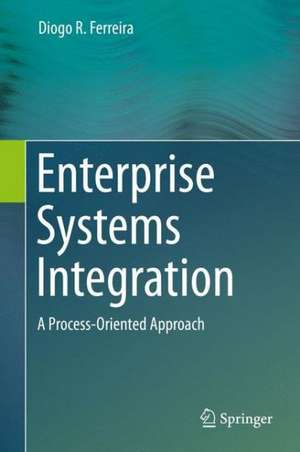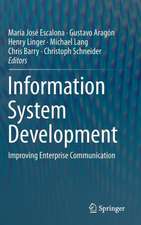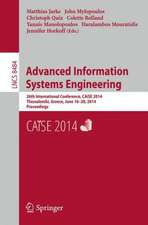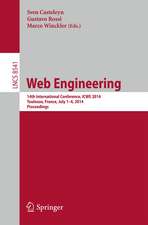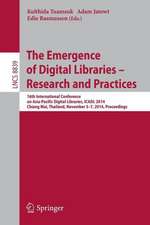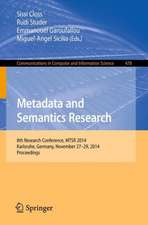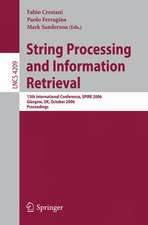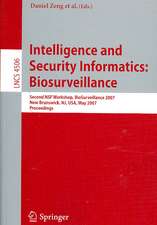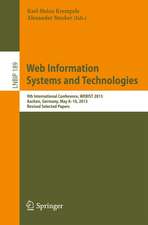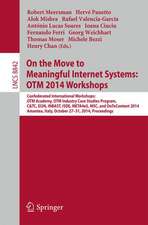Enterprise Systems Integration: A Process-Oriented Approach
Autor Diogo R. Ferreiraen Limba Engleză Hardback – 17 dec 2013
This book addresses integration with a view towards supporting business processes. From messaging systems to data and application adapters, and then to services, orchestrations, and choreographies, the focus is placed on the connection between systems and business processes, and particularly on how it is possible to develop an integrated application infrastructure in order to implement the desired business processes. For this purpose, the text follows a layered, bottom-up approach, with application-oriented integration at the lowest level, followed by service-oriented integration and finally completed by process-oriented integration at the topmost level. The presentation of concepts is accompanied by a set of instructive examples using state-of-the-art technologies such as Java Message Service (JMS), Microsoft Message Queuing (MSMQ), Web Services, Microsoft BizTalk Server, and the Business Process Execution Language (BPEL).
The book is intended as a textbook for advance undergraduate or beginning graduate students in computer science, especially for those in an information systems curriculum. IT professionals with a background in programming, databases and XML will also benefit from the step-by-step description of the various integration levels and the related implementation examples.
| Toate formatele și edițiile | Preț | Express |
|---|---|---|
| Paperback (1) | 370.62 lei 38-44 zile | |
| Springer Berlin, Heidelberg – 23 aug 2016 | 370.62 lei 38-44 zile | |
| Hardback (1) | 543.31 lei 6-8 săpt. | |
| Springer Berlin, Heidelberg – 17 dec 2013 | 543.31 lei 6-8 săpt. |
Preț: 543.31 lei
Preț vechi: 679.14 lei
-20% Nou
Puncte Express: 815
Preț estimativ în valută:
103.97€ • 109.04$ • 86.55£
103.97€ • 109.04$ • 86.55£
Carte tipărită la comandă
Livrare economică 01-15 aprilie
Preluare comenzi: 021 569.72.76
Specificații
ISBN-13: 9783642407956
ISBN-10: 3642407951
Pagini: 404
Ilustrații: XIV, 387 p. 147 illus.
Dimensiuni: 155 x 235 x 27 mm
Greutate: 0.74 kg
Ediția:2013
Editura: Springer Berlin, Heidelberg
Colecția Springer
Locul publicării:Berlin, Heidelberg, Germany
ISBN-10: 3642407951
Pagini: 404
Ilustrații: XIV, 387 p. 147 illus.
Dimensiuni: 155 x 235 x 27 mm
Greutate: 0.74 kg
Ediția:2013
Editura: Springer Berlin, Heidelberg
Colecția Springer
Locul publicării:Berlin, Heidelberg, Germany
Public țintă
GraduateCuprins
Part I Introduction.- Evolution of Enterprise Systems.- Introduction to BizTalk Server.- Part II Messaging.- Messaging Systems.- Message Brokers.- Part III Adapters.- Data Adapters.- Application Adapters.- Part IV Orchestrations.- Services and SOA.- Orchestration Flow.- Advanced Constructs.- Orchestrations with BPEL.- Part V Processes.- Process modeling with BPMN.- Inter-Organizational Processes.
Recenzii
From the reviews:
"The author has done a very good job of compiling and structuring the major systems integration-related concepts into an almost 400-page book. […] Overall, the book is timely and deals with the topic of systems integration very nicely. I would strongly recommend it to the integration developer/designer/architect communities, process managers, and undergraduate and graduate students in the field of information technology." Sajjad Khan, ACM Computing Reviews, June 2014
"The author has done a very good job of compiling and structuring the major systems integration-related concepts into an almost 400-page book. […] Overall, the book is timely and deals with the topic of systems integration very nicely. I would strongly recommend it to the integration developer/designer/architect communities, process managers, and undergraduate and graduate students in the field of information technology." Sajjad Khan, ACM Computing Reviews, June 2014
Notă biografică
Diogo R. Ferreira is Professor of Information Systems at the IST – Technical University of Lisbon and a member of the IEEE Task Force on Process Mining. He holds a PhD from the University of Porto on the application of workflow systems to business networking, and his research interests include process mining, business process modeling, enterprise application integration, inter-organizational processes, service-oriented architectures, and context-aware services and applications. In addition, he is in charge of BSc-, MSc-, and PhD-level courses at the T.U. Lisbon in the areas of database systems, enterprise integration, and BPM systems, respectively.
Textul de pe ultima copertă
The field of enterprise systems integration is constantly evolving, as every new technology that is introduced appears to make all previous ones obsolete. Despite this continuous evolution, there is a set of underlying concepts and technologies that have been gaining an increasing importance in this field. Examples are asynchronous messaging through message queues, data and application adapters based on XML and Web services, the principles associated with the service-oriented architecture (SOA), service composition, orchestrations, and advanced mechanisms such as correlations and long-running transactions. Today, these concepts have reached a significant level of maturity and they represent the foundation over which most integration platforms have been built.
This book addresses integration with a view towards supporting business processes. From messaging systems to data and application adapters, and then to services, orchestrations, and choreographies, the focus is placed on the connection between systems and business processes, and particularly on how it is possible to develop an integrated application infrastructure in order to implement the desired business processes. For this purpose, the text follows a layered, bottom-up approach, with application-oriented integration at the lowest level, followed by service-oriented integration and finally completed by process-oriented integration at the topmost level. The presentation of concepts is accompanied by a set of instructive examples using state-of-the-art technologies such as Java Message Service (JMS), Microsoft Message Queuing (MSMQ), Web Services, Microsoft BizTalk Server, and the Business Process Execution Language (BPEL).
The book is intended as a textbook for advance undergraduate or beginninggraduate students in computer science, especially for those in an information systems curriculum. IT professionals with a background in programming, databases and XML will also benefit from the step-by-step description of the various integration levels and the related implementation examples.
This book addresses integration with a view towards supporting business processes. From messaging systems to data and application adapters, and then to services, orchestrations, and choreographies, the focus is placed on the connection between systems and business processes, and particularly on how it is possible to develop an integrated application infrastructure in order to implement the desired business processes. For this purpose, the text follows a layered, bottom-up approach, with application-oriented integration at the lowest level, followed by service-oriented integration and finally completed by process-oriented integration at the topmost level. The presentation of concepts is accompanied by a set of instructive examples using state-of-the-art technologies such as Java Message Service (JMS), Microsoft Message Queuing (MSMQ), Web Services, Microsoft BizTalk Server, and the Business Process Execution Language (BPEL).
The book is intended as a textbook for advance undergraduate or beginninggraduate students in computer science, especially for those in an information systems curriculum. IT professionals with a background in programming, databases and XML will also benefit from the step-by-step description of the various integration levels and the related implementation examples.
Caracteristici
Comprehensive step-by-step description of various integration levels Clearly connects theoretical concepts with industry-leading products and standards Gradually and systematically reveals “the big picture” of enterprise systems integration Illustrates every step and layer with the help of implementation examples Includes supplementary material: sn.pub/extras
